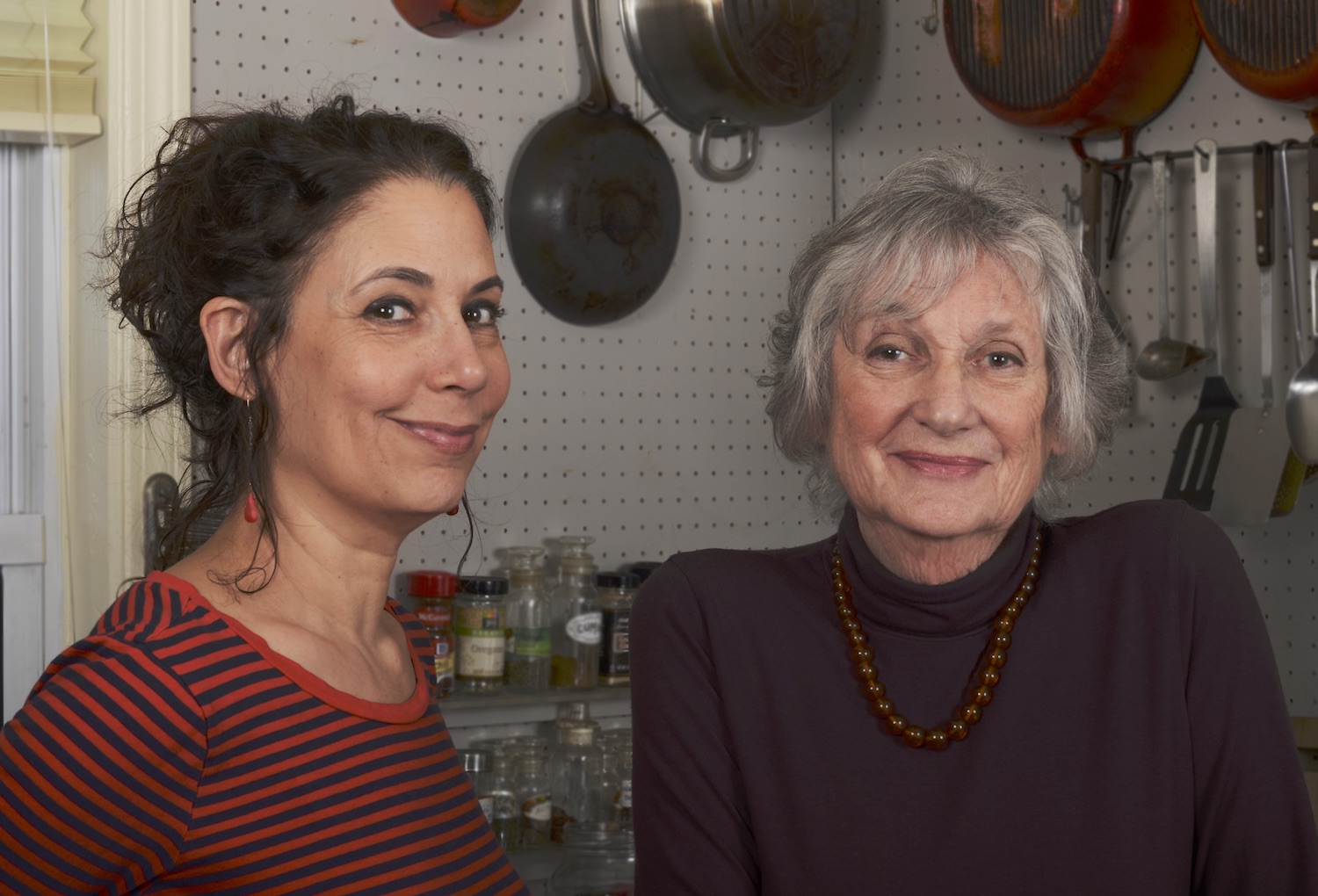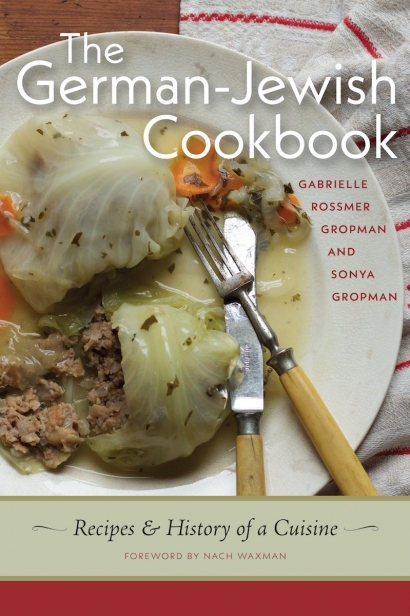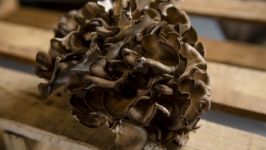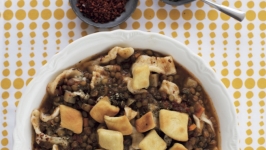The German-Jewish Cookbook
All cookbooks, at some level, are aspirational or nostalgic. Some tell you how you ought to live, and some delve into a lost culture from the old country, pages filled with family secrets coaxed from formidable matriarchs.
The German-Jewish Cookbook, by mother and daughter Gabrielle “Gaby” Rossmer Gropman and Sonya Gropman, is a bit of both. That’s because when you attempt to revive a culture and cuisine that was deliberately eradicated, it isn’t just about nostalgia. There’s a fondness for recipes past, and a desire to live up to them. There’s also the inevitable, looming question: What would all this look, feel, taste like if we’d never had to leave?
The German-Jewish Cookbook is not about Jewish food as we think of it today: It includes no hummus and falafel, nor do bagels and lox make an appearance. There is no schnitzel, sauerbraten or bratwurst. German-Jewish cuisine branched off before World War II, like an obscure dialect of the language, the culinary Yiddish to German’s Hochdeutsch, and some of the Gropmans’ recipes can seem old-fashioned. A few use ingredients, like carp, that are hard to come by. But to anyone who has spent time in Germany, these recipes are eerily familiar. To anyone old enough to remember post-war Jewish New York (including vibrant Washington Heights, where Gaby grew up), this cookbook is a vital document of a particular time and place.
A deceptively simple prologue follows Stephen Rossmer—Gaby’s father, Sonya’s grandfather—as he revisits his hometown of Bamberg, Germany, and rediscovers a flavor he’d thought lost. No costly delicacy, just a humble root vegetable: “We had never seen them before, but realized these must be the fabled black radishes that Stephen had searched for during his entire 34 years in the United States, to no avail.”
In Germany, seasonal fruits and vegetables are culinary royalty, welcomed with carnivals, kiosks and restaurant menus before disappearing again for the rest of the year. Such delights show up most notably in the cookbook’s dessert recipes, from yeasty plum cake (Pflaumenkuchen), still a late-summer staple in German households, to the berry pudding Rote Grütze, which makes use of currants—hard to find in America, ubiquitous in Germany. It is these ephemeral products that form a community of the mind (you know you’re with a German when they start waxing poetic about weisser Spargel—white asparagus), a community of those who left and those forcibly removed. As Gaby explained in a phone call, “It’s what you can carry with you so clearly and easily; it fits all your senses. When everything else is gone you can, if you have the right circumstances, continue with food.”
I didn’t realize I belonged to this community, too, until I left Germany after nearly a decade. My departure was by choice, but I couldn’t shake the feeling that something had been lost. When you leave a place for good, all the knowledge you’ve stored up over the years has nowhere to go. Suddenly, there are routes you can clear from your memory, customs you needn’t think about, products you’ll no longer scour supermarkets for. I didn’t think much of the dishes I’d eaten in Germany until I couldn’t get them anymore. Meanwhile, for Jews who had to leave Germany, rebuilding their lives had much to do with rebuilding their kitchens.
Yet, this isn’t just a cookbook. Both authors’ memories embellish the book, along with museum-like images of the family’s kitchen tools—a mandoline, a mezzaluna, a silver creamer—tucked among photos of stuffed cabbage rolls and beef tongue in red wine. Each object, like each recipe, is part of a heritage, and stories of the war and its aftermath, based on the Gropmans’ interviews with both Jews and Gentiles, make clear that preserving this heritage was a group effort. There’s Emmy Zink, who can still duplicate recipes she learned from the Jewish Scheler family when her parents worked for them before the war. There’s Friedel Körten, whose bakery in Bamberg still makes Berches, a challah-like ceremonial bread. We speak often of those who hid, defended or rescued Jews during the war, but these faithful cooks and bakers, who have at times single-handedly kept a culinary tradition alive, also deserve our respect.
The Jewish-German community in Washington Heights has now all but dispersed. Gaby lives in Boston, Sonya in Jackson Heights. I wonder whether this book, in a way, was their attempt to relive those heady post-war years when Jewish Germany was reassembling itself in a few blocks of Upper Manhattan. To be part of the Jewish diaspora, we are told, is always to be longing for the Jewish homeland. Yet here was one right in front of their eyes, hitting their taste buds, wafting into their noses as they sat down around the family table, alive, finally able to thrive, and finally home.
Sonya's Go-To Spots in Jackson Heights
The weekly market often has hard-to-find ingredients for recipes in our book, including sour cherries in summer, parsley root, duck and duck fat.
Farm Spot
The Jackson Heights CSA (which I also help run)—our weekly box often includes kohlrabi and celery root, two vegetables used in our book. Also, the most incredible potatoes, which Long Island is famous for!
European Appetite Delicatessen
A Russian deli, which stocks, among many other items, a variety of pickled herring, preserved cherries and brown bread.
A wine shop with a lovely collection.
A Colombian bakery and restaurant, a favorite place to stop for a coffee and snack (empanadas, arepas, pan de yuca), or a simple, quick meal.
An Indian sweets shop that also has a steam table of vegetarian food. Regular stop for a quick bite, always fresh and tasty with an interesting selection.
La Quesadilla Sabrosa Taqueria
My taco cart of choice, near the subway station on Roosevelt Ave., where I generally order the same thing: a mushroom quesadilla.
For espresso cortado, pastry and a meet-up with friends in the neighborhood.
The German-Jewish Cookbook
Gabrielle “Gaby” Rossmer Gropman | @gabriellerossmer
Sonya Gropman | @sonyagrop
Jackson Heights Greenmarket
Jackson Heights CSA
European Appetite Delicatessen
Table Wine | @tablewineny
La Casa de Los Antojitos
Rajbhog Sweets and Snacks | @rajbhogny
La Quesadilla Sabrosa Taqueria
Espresso 77 | @espresso77newyork








